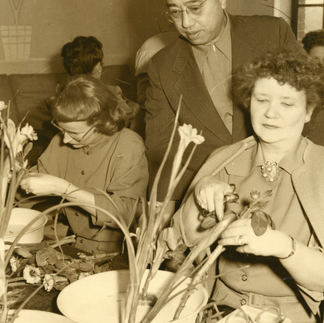Ikebana: Art in Motion
- foliomag
- Mar 21
- 2 min read
By: Madomi Kusano
Ikebana (生け花), the Japanese art of flower arrangement, is a quiet exchange between nature and artistic vision, a fleeting sculpture where life, space, and time are woven together. The philosophy of ikebana is rooted in Japanese aesthetics and Buddhist values that emphasize simplicity, balance, and harmony with nature. Floral form, texture and space are not static but experienced in motion. With every passing moment, petals fade, leaves curl, and stems bend, making the work appear in a constant state of transformation.
Sōfū Teshigahara, the founder of the Sōgetsu School of Ikebana, redefined the art form by
integrating unconventional materials and sculptural forms, transforming ikebana into a dynamic visual art. Sōfū’s works play with stark contrasts, pairing delicate flowers with angular metal rods and weathered pieces of wood, pushing ikebana beyond the confines of floral arrangement and into the realm of sculpture. Through large-scale installations, he further blurred the boundaries between ikebana and contemporary art, where the flowers, branches, and empty spaces cease to be static objects but instead convey movement, tension, and vulnerability. In his words, “Flowers become human in ikebana.”
To honour both Sōfū’s legacy and the rich history of the Sōgetsu School, Iemoto Akane
Teshigahara delivered a captivating live ikebana performance showcasing ikebana as a
dynamic, evolving art form. Akane arranged four types of cherry blossoms in vessels of previous Iemoto (headmasters), symbolizing gratitude and reflecting on both the accumulated years and the limitless possibilities of the future. Her artistic expression focused on the beauty of the materials and the process of their arrangement, as she brought the sculpture to life.
Ikebana is defined by its inherent movement—a dynamic sculpture that continuously evolves
with time. When an artist arranges the flowers, they are not merely placing them into a set form; they are responding to the materials in real time, attuning to their movement, balance, and natural flow. This process of creation is intertwined with the process of decay, giving ikebana a unique cyclical quality where life and death, beauty and imperfection are intimately bound. This art in motion transcends the visual and becomes an embodiment of time itself, connecting the artist with the changing materials and creating a piece that continually interacts with the environment around it.
Farewell Sogetsu Atelier Studio’ Ikebana performance by Iemoto Akane:










Σχόλια